Kukkarahalli Lake
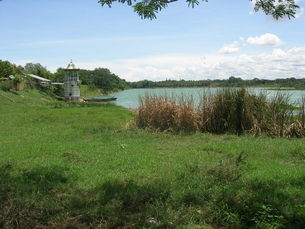
Kukkarahalli Lake also called Kukkarhalli Kere, located in the heart of the Mysore city, adjoins the Manasgangotri (University of Mysore), the Kalamandir (Rangyana) and the Central Food Technological Research Institute (CFTRI) campus separated by the Hunsur Road.
The lake also has India's largest walk through aviary. The lake has boating facilities that are available on all days except Tuesday.It provides lung-space to the city. The Lake drains a catchment area of more than 414 square kilometers and the water body spreads over 62 hectares (150 acres). Dewan Poornaiah feeder canal, 27 km long, which passes through Hinkal, Bogadi, Kudremala and Manasagangotri outfalls into the Lake.
The Lake is ‘J’ shaped. The maximum depth of lake is reported to be 5 m (16 ft). The east-west bound holds water on one side. Sandy loam to clay loam form the dominant geological condition of the Lake. On the northern side another temporary bound hold back the direct flow of waste water into the lake.
The lake also has India's largest walk through aviary. The lake has boating facilities that are available on all days except Tuesday.It provides lung-space to the city. The Lake drains a catchment area of more than 414 square kilometers and the water body spreads over 62 hectares (150 acres). Dewan Poornaiah feeder canal, 27 km long, which passes through Hinkal, Bogadi, Kudremala and Manasagangotri outfalls into the Lake.
The Lake is ‘J’ shaped. The maximum depth of lake is reported to be 5 m (16 ft). The east-west bound holds water on one side. Sandy loam to clay loam form the dominant geological condition of the Lake. On the northern side another temporary bound hold back the direct flow of waste water into the lake.
History
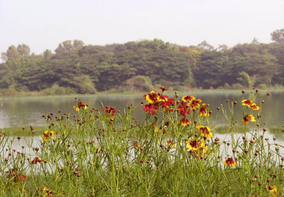
Mummadi Krishnaraja Wodeyar, (1794 – 1868) of the Mysore Dynasty (Kingdom of Mysore) was responsible for getting the lake created, in the year 1864, to provide water for irrigation to about 4000 ha (10,000 acres) of land outside the city. The Lake also used to be a source of water supply to the city of Mysore but over the years, sewage and excessive land encroachments (mostly illegal) and blockage of water flow sources almost led to the eutropohication of the lake. The University of Mysore and the citizen forums of Mysore continue to make efforts to preserve the lake by implementing several remedial measures.
A detailed study of the physio-chemical and bio-chemical parameters of the lake waters carried out in the period 1981-2001 confirmed the deteriorating status of the lake necessitating action for restoration. During the year 2003-2004, with grants of about US $ 0.2 million (Rs 91 lakhs) provided by the Asian Development Bank, Karnataka Urban Infrastructure Development Corporation (KUIDFC) in association with the University of Mysore under whose jurisdiction the Lake falls and citizens groups, carried out the restoration works of the lake.
The lake was once a big attraction to bird watchers. According to Naturalists, about 180 species of birds (a large number of them migratory birds, including birds from Siberia) with 10,000 to 15,000 of them visited the lake during winter to roost. Organised bird watching expeditions around the lake used to be actively pursued by the Mysore Amateur Naturalists (MAN) Association. In recent years, with the lake getting into a eutrophic state (though since restored), the number of birds visiting the lake has substantially decreased. Now, the number of birds visiting the lake has reduced to about 2,000. They are found to breed in the isolated bird island. The birds now found in the lake (some of the birds are pictured in the gallery) are Spot-billed Pelicans, Little Cormorant, Painted Storks, Openbill Storks, Eurasian Spoonbills, Black-crowned Night Herons and Oriental Darters.
A detailed study of the physio-chemical and bio-chemical parameters of the lake waters carried out in the period 1981-2001 confirmed the deteriorating status of the lake necessitating action for restoration. During the year 2003-2004, with grants of about US $ 0.2 million (Rs 91 lakhs) provided by the Asian Development Bank, Karnataka Urban Infrastructure Development Corporation (KUIDFC) in association with the University of Mysore under whose jurisdiction the Lake falls and citizens groups, carried out the restoration works of the lake.
The lake was once a big attraction to bird watchers. According to Naturalists, about 180 species of birds (a large number of them migratory birds, including birds from Siberia) with 10,000 to 15,000 of them visited the lake during winter to roost. Organised bird watching expeditions around the lake used to be actively pursued by the Mysore Amateur Naturalists (MAN) Association. In recent years, with the lake getting into a eutrophic state (though since restored), the number of birds visiting the lake has substantially decreased. Now, the number of birds visiting the lake has reduced to about 2,000. They are found to breed in the isolated bird island. The birds now found in the lake (some of the birds are pictured in the gallery) are Spot-billed Pelicans, Little Cormorant, Painted Storks, Openbill Storks, Eurasian Spoonbills, Black-crowned Night Herons and Oriental Darters.
Area
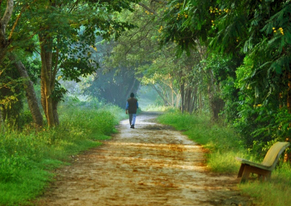
Kukkarahalli Lake is spread over 58 hectares with a shoreline of roughly five kilometers in Manasagangothri, the sprawling campus of the University of Mysore. Mummadi Krishnaraja Wodeyar was responsible for getting the lake created, in the year 1864, to provide water for irrigation to about 10,000 acres of land outside the city. Reckoned to be a jewel in the crown of Mysore, the picturesque lake, which inspired poet laureate Kuvempu to pen many of his works, provides the much-needed lung-space to the city. This lake is home to more than 180 species of birds, some of them aquatic. During the migratory season the lake plays host to a variety of winged visitors, some from as far as Siberia. The birds found in the lake are Spot-billed Pelicans, Little Cormorant, Painted Storks, Open-bill Storks, Eurasian Spoonbills, Black-crowned Night Herons and Oriental Darters. Bird life International has included Kukkarahalli Lake in the list of 38 Important Bird Areas (IBAs) in Karnataka.
The views from the north shore is particularly attractive with the lake and its surrounding trees, the spire of the deputy commissioner's offices rising above them and the low rise of the Chamundi Hill in the background. The 4.5 Kms walking path circumvents the lake with shaded stone benches for visitors to sit, relax and enjoy the scenic serenity of the lake. Kukkarahalli Lake is a popular destination for both morning & evening walkers.
The views from the north shore is particularly attractive with the lake and its surrounding trees, the spire of the deputy commissioner's offices rising above them and the low rise of the Chamundi Hill in the background. The 4.5 Kms walking path circumvents the lake with shaded stone benches for visitors to sit, relax and enjoy the scenic serenity of the lake. Kukkarahalli Lake is a popular destination for both morning & evening walkers.
Bird Watching
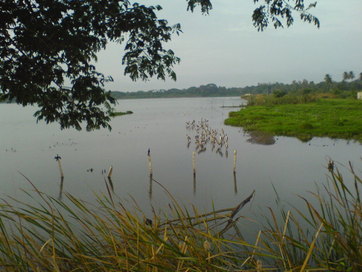
The lake was once a big attraction to bird watchers. According to Naturalists, about 180 species of birds (a large number of them migratory birds, including birds from Siberia) with 10,000 to 15,000 of them visited the lake during winter to roost. Organized bird watching expeditions around the lake used to be actively pursued by the Mysore Amateur Naturalists (MAN) Association. In recent years, with the lake getting into a entropic state (though since restored), the number of birds visiting the lake has substantially decreased. Now, the number of birds visiting the lake has reduced to about 2,000. They are found to breed in the isolated bird island. The birds now found in the lake (some of the birds are pictured in the gallery) are Spot-billed Pelicans, Little Cormorant, Painted Storks, Open bill Storks, Eurasian Spoonbills, Black-crowned Night Herons and Oriental Darters. Bird life International has included Kukkarahalli Lake in the list of 38 important Important Bird Areas (IBAs) in the State or Karnataka.
Lake Restoration
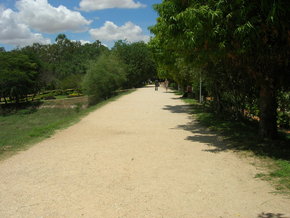
During the year 2003-2004, with grants of about US $ 0.2 million (Rs 91 lakhs) provided by the Asian Development Bank, Karnataka Urban Infrastructure Development Corporation (KUIDFC) in association with the University of Mysore under whose jurisdiction the Lake falls and citizens groups, carried out the restoration works of the lake. In order to effectively reduce the external loading of pollutants and the intervention of wastes into the lake ecosystem the measures implemented have covered the following with funds provided by the Asian Development Bank.
- Widening of the bund on the southern side,
- Forming a new walkway on the western side for the benefit large number of morning walkers who visit the lake,
- Shaded (bougainvillea creepers) stone benches for visitors to sit, relax and enjoy the scenic serenity of the lake.
- Improving the eastern and the northern pathway,
- Fencing of the lake perimeter
- The iron watch tower (within the lake) about 100 feet (30 m) from the shores has been restored
- Lighting arrangement along the southern bund.
- Adopting rainwater harvesting methods to improve the quality and quantity of water inflows
- Augmenting supply to the lake with fresh water inflow with filtered municipal back water wash
- Adopting aeration of water techniques: boating is one of the methods widely adopted houses - a boating center has been established
- Removal of algae by manual methods
- Engineering methods to clean the boundary conditions of the lake such as desilting and opening of the intake channel
- Ban on immersion of idols during festivals
- Banned dumping of medical waste in the lake
- Increased security system to restrict human influence
- Increased aquaculture
- Stakeholders participation for collective ownership and responsibility to restoration activities
Visiting Timings
6 a.m to 6 p.m















